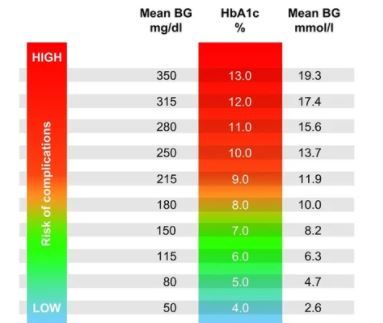- Clinical Technology
- Adult Immunization
- Hepatology
- Pediatric Immunization
- Screening
- Psychiatry
- Allergy
- Women's Health
- Cardiology
- Pediatrics
- Dermatology
- Endocrinology
- Pain Management
- Gastroenterology
- Infectious Disease
- Obesity Medicine
- Rheumatology
- Nephrology
- Neurology
- Pulmonology
Cardiovascular Risk Found Greatest in Prediabetes A1c Range
For individuals with A1c of 6.4-6.5%, just below the threshold for diabetes, risk of MACE was higher than for any other subgroup with A1c values ranging from 5.8-6.8%.
©Sophia Winters/stock.adobe.com

Individuals with A1c considered in the “prediabetes” range may have the highest risk for major adverse cardiovascular events (MACE) and all-cause mortality, suggest results of a Danish nationwide study published in Diabetes Care.
The authors, led by Sam Kafai Yahyavi, from Rigshospitalet, Copenhagen, Denmark, say the findings “raise the question of whether medical treatment should be more aggressive and whether we should start treating cardiovascular risk factors even before the patients cross the diabetes threshold.”
Using Danish registry databases, Yahyavi and colleagues identified 326 305 patients with a first measured A1c of 5.8% to 6.8% (40–51 mmol/mol) between 2011 and 2017. After excluding patients with prior CV and renal disease and those on treatment for a range of cardiometabolic conditions, the final group of 84 678 patients was stratified by A1c into 6 subgroups: 40–41 mmol/mol (5.8–5.9%), 42–43 mmol/mol (6.0–6.1%), 44–45 mmol/mol (6.2–6.3%), 46–47 mmol/mol (6.4–6.5%), 48–49 mmol/mol (6.5–6.6%), 50–51 mmol/mol (6.7–6.8%).
Median age ranged from 58.4 year to 61.8 years across groups which were also generally comparable regarding demographics and comorbidities.
The investigators identified first occurrence of MACE (nonfatal myocardial infarction, nonfatal stroke, or death from CV causes) as the primary endpoint; secondary endpoints included all-cause mortality and initiation of medication.
RESULTS
The researchers report that, during 1 year of follow-up, the overall incidence of MACE was 0.94%. They observed a dose-response relationship between higher A1c and incident MACE in the A1c range between 5.8-6.5%.
Individuals with a first measured A1c of 6.2% to 6.3% (n=8694) had a significant 1.35-fold higher risk for MACE than those with a first A1c of 5.8% to 5.9% (n=48,157), after adjustment for potential confounders.
This increased to a significant 1.91-fold higher risk among individuals with a baseline A1c of 6.4% to 6.5% (n=3374). The standardized absolute risk for MACE in this group was 1.73% compared with 0.95% in the group with the lowest A1c levels.
The adjusted hazard ratios for MACE among individuals past the threshold for diabetes, ie, A1c groups 6.5%-6.6% (n=2047) and 6.7%-6.8% (n=1173), were nonsignificant at 1.14 and 1.63, respectively, when compared with the lowest A1c group.
Findings for all-cause mortality followed a pattern similar to that for MACE, with those in the A1c 6.4%-6.5% group having the highest risk relative to those in the 5.8%-5.9% reference group.
When researchers analyzed prescribed medication during the follow-up period, they found that the proportions of participants who initiated glucose-lowering medications, statins, renin-angiotensin system inhibitors, and acetylsalicylic acid increased as A1c increased.
For glucose-lowering medications the increase was particularly steep, rising from 2.75% of individuals in the A1c 6.2% to 6.3% group initiating the drugs to 43.82% of those in the 6.7–6.8% group taking them for the first time. The corresponding proportions for statins were 9.20% to 27.02%.
Yahyavi et al note that the highest risk for MACE and all-cause mortality as well as the lower cumulative incidence of initiation of cardioprotective and glucose-lowering medications were all identified in the group just below the diagnostic threshold for diabetes A1c 6.4%-6.5% vs those just above it.
They suggest that the lower risk in and the higher prescribing for those with A1c ≥6.5% “is connected to the more aggressive treatment of cardiovascular risk factors initiated among patients with diagnosed diabetes as recommended in national guidelines compared with treatment of patients with prediabetes.”
They suggest, too, that persons with diabetes are more likely than those with prediabetes to receive diabetes self-management education with a focus on dietary and lifestyle change.
Yahyavi and colleagues conclude that their data “support the hypothesis that treatment for cardiovascular risk factors should start before type 2 diabetes develops and suggest that more attention and potentially evidence-based guidelines are needed in the management of prediabetes with better monitoring of this patient group.”
Reference: Yahyavi SF, Snorgaard O, Knop FK, et al. Prediabetes defined by first measured HbA1c predicts higher cardiovascular risk compared with HbA1c in the diabetes range: a cohort study of nationwide registries. Diabetes Care. 2021;44:dc211062.
